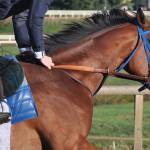Can a Nasal Strip Minimize Pulmonary Bleeding in Exercising Horses?

The purpose of this study was to examine the effects of an external nasal strip (NS), furosemide (FR), and a combination of the two treatments (NS + FR) on exercise-induced pulmonary hemorrhage (EIPH) in Thoroughbred horses. It was hypothesised that both the NS and FR would attenuate EIPH as assessed by red blood cell count in bronchoalveolar lavage fluid.
In random order, 8 horses completed each of 4 sprint exercise tests on a treadmill: 1) NS; 2) FR (0.5 mg/kg bwt i.v., 4 h pre-exercise); 3) NS + FR; and 4) control (C; no treatment). After a 5 min warm-up (4.5 m/s), horses completed 2 min running at 120% maximum oxygen consumption (Vo2max) with the treadmill set at 3° incline. Mean ± s.d. running speed was 14.2 ± 0.2 m/s. In the FR and NS + FR trials, horses carried weight equal to that lost as a result of furosemide administration. During exercise at 120%V̇O2max, oxygen consumption (Vo2) and carbon dioxide production (Vco2) were measured at 15 s intervals. Plasma lactate concentration was measured in samples collected before exercise, at the end of the sprint and after 5 min cool-down at the trot. Thirty minutes after the run, bronchoalveolar lavage (BAL) was performed and the red cell count in the fluid quantified.
Vo2 and Vco2 were significantly lower in NS and NS + FR trials than in the C and FR trials at the end of the sprint exercise protocol. However, plasma lactate concentrations did not differ among treatments. Compared with the C trial (61.1 ± 30.5 × 106 red blood cells/ml BAL fluid), pulmonary hemorrhage was significantly decreased in both the NS and FR trials. EIPH in the NS + FR trial was further diminished compared to the NS trial, but not different from the FR trial.
We conclude that both the external nasal strip and furosemide attenuate pulmonary hemorrhage in Thoroughbred horses during high-speed sprint exercise. The external nasal strip appears to lower the metabolic cost of supramaximal exertion in horses. Given the purported ergogenic effects of furosemide, the external nasal strip is a valuable alternative for the attenuation of EIPH.
This report of KER’s 2001 research was published in Equine Veterinary Journal.
Read the entire research report, titled Effects of an External Nasal Strip and Frusemide on Pulmonary Haemorrhage in Thoroughbreds Following High-Intensity Exercise.








